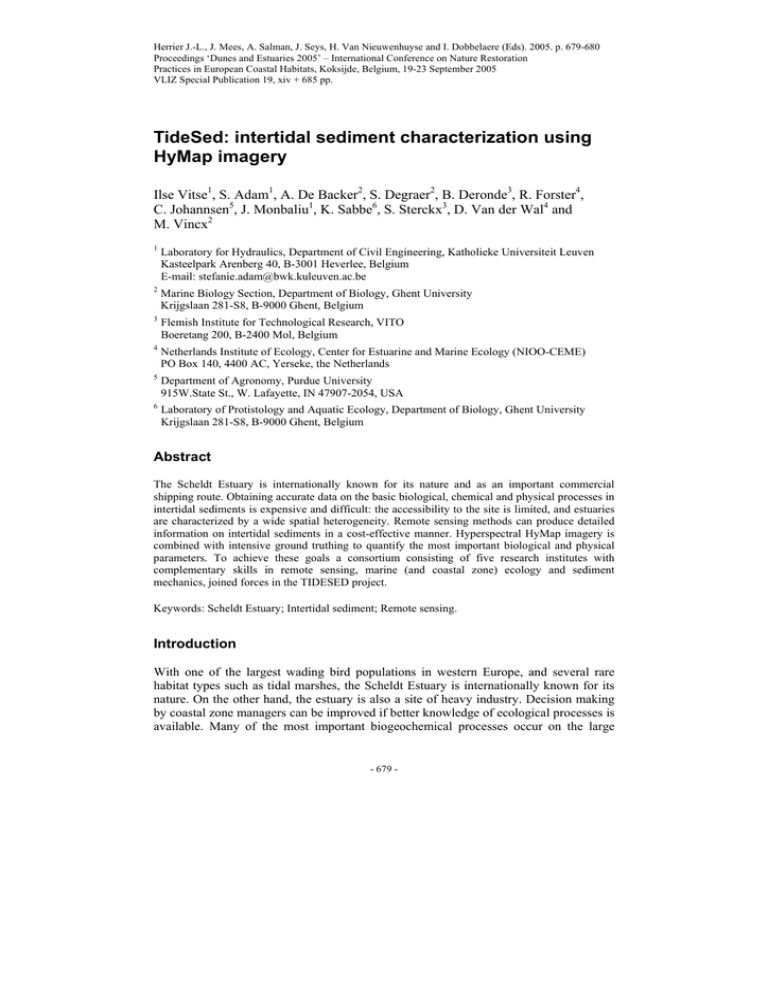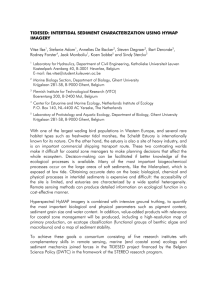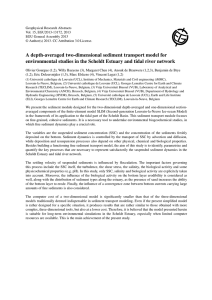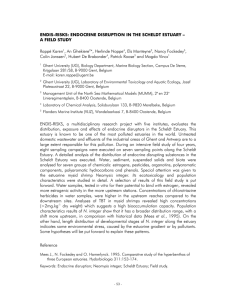Document 11427609
advertisement

Herrier J.-L., J. Mees, A. Salman, J. Seys, H. Van Nieuwenhuyse and I. Dobbelaere (Eds). 2005. p. 679-680 Proceedings ‘Dunes and Estuaries 2005’ – International Conference on Nature Restoration Practices in European Coastal Habitats, Koksijde, Belgium, 19-23 September 2005 VLIZ Special Publication 19, xiv + 685 pp. TideSed: intertidal sediment characterization using HyMap imagery Ilse Vitse1, S. Adam1, A. De Backer2, S. Degraer2, B. Deronde3, R. Forster4, C. Johannsen5, J. Monbaliu1, K. Sabbe6, S. Sterckx3, D. Van der Wal4 and M. Vincx2 1 Laboratory for Hydraulics, Department of Civil Engineering, Katholieke Universiteit Leuven Kasteelpark Arenberg 40, B-3001 Heverlee, Belgium E-mail: stefanie.adam@bwk.kuleuven.ac.be 2 Marine Biology Section, Department of Biology, Ghent University Krijgslaan 281-S8, B-9000 Ghent, Belgium 3 Flemish Institute for Technological Research, VITO Boeretang 200, B-2400 Mol, Belgium 4 Netherlands Institute of Ecology, Center for Estuarine and Marine Ecology (NIOO-CEME) PO Box 140, 4400 AC, Yerseke, the Netherlands 5 Department of Agronomy, Purdue University 915W.State St., W. Lafayette, IN 47907-2054, USA 6 Laboratory of Protistology and Aquatic Ecology, Department of Biology, Ghent University Krijgslaan 281-S8, B-9000 Ghent, Belgium Abstract The Scheldt Estuary is internationally known for its nature and as an important commercial shipping route. Obtaining accurate data on the basic biological, chemical and physical processes in intertidal sediments is expensive and difficult: the accessibility to the site is limited, and estuaries are characterized by a wide spatial heterogeneity. Remote sensing methods can produce detailed information on intertidal sediments in a cost-effective manner. Hyperspectral HyMap imagery is combined with intensive ground truthing to quantify the most important biological and physical parameters. To achieve these goals a consortium consisting of five research institutes with complementary skills in remote sensing, marine (and coastal zone) ecology and sediment mechanics, joined forces in the TIDESED project. Keywords: Scheldt Estuary; Intertidal sediment; Remote sensing. Introduction With one of the largest wading bird populations in western Europe, and several rare habitat types such as tidal marshes, the Scheldt Estuary is internationally known for its nature. On the other hand, the estuary is also a site of heavy industry. Decision making by coastal zone managers can be improved if better knowledge of ecological processes is available. Many of the most important biogeochemical processes occur on the large - 679 - I. Vitse et al. areas of loose sediments which are exposed at low tide. For example, the distribution and binding of heavy metals is controlled by the fraction of fine sediment. Photosynthesis by benthic microalgae fuels primary production, supporting many grazing animals and birds. Accumulations of algal cells in a surface biofilm cause the sediment to become more stable. However, grazing and bioturbation by macrofauna enhances the erosion rate. Methodology Hyperspectral HyMap imagery of the Molenplaat in the Westerscheldt is combined with intensive ground truth measurements of materials of interest (MOIs). The sediment samples are analyzed on grain size distribution, water content, pigments, and biological composition (macrofauna and microphytobenthos). The location of each sediment sample is determined by differential GPS measurements. For each material of interest, hyperspectral features from HyMap will be matched to ground measurements at the relevant pixel in order to produce predictive algorithms. In addition, value-added products with relevance for coastal zone management will also be produced. For example, benthic primary production will be calculated at each pixel from knowledge of benthic chlorophyll and light availability and sediment stability will be assessed from the biophysical properties of sediment, elevation and hydrodynamics. First results The HyMap image and field measurements were obtained on 8 June 2004 (Fig. 1). The field measurements are being interpreted. Supervised and unsupervised classifications are being performed to produce maps of the MOIs. Preliminary results show that intertidal sediments can be classified using HyMAP imagery. Fig. 1. Black and white representation of the HyMap image of the Molenplaat. Acknowledgements This project is financed by the Belgian Science Policy Office in the framework of the STEREO research program. We would like to thank the Flanders Marine Institute (VLIZ) and the Flemish Institute for Technological Research (VITO) for their help and loan of equipment during the field measurements. - 680 -








